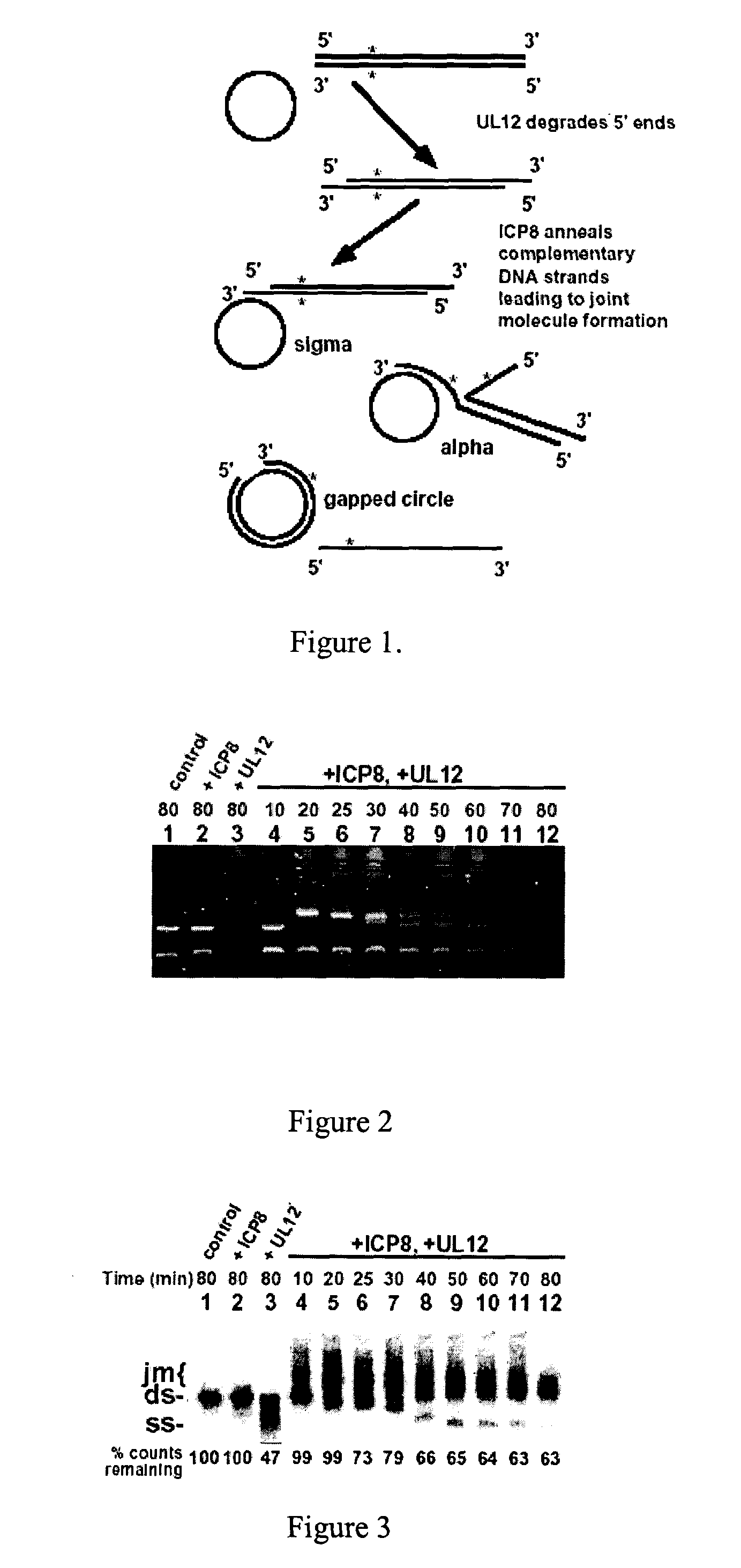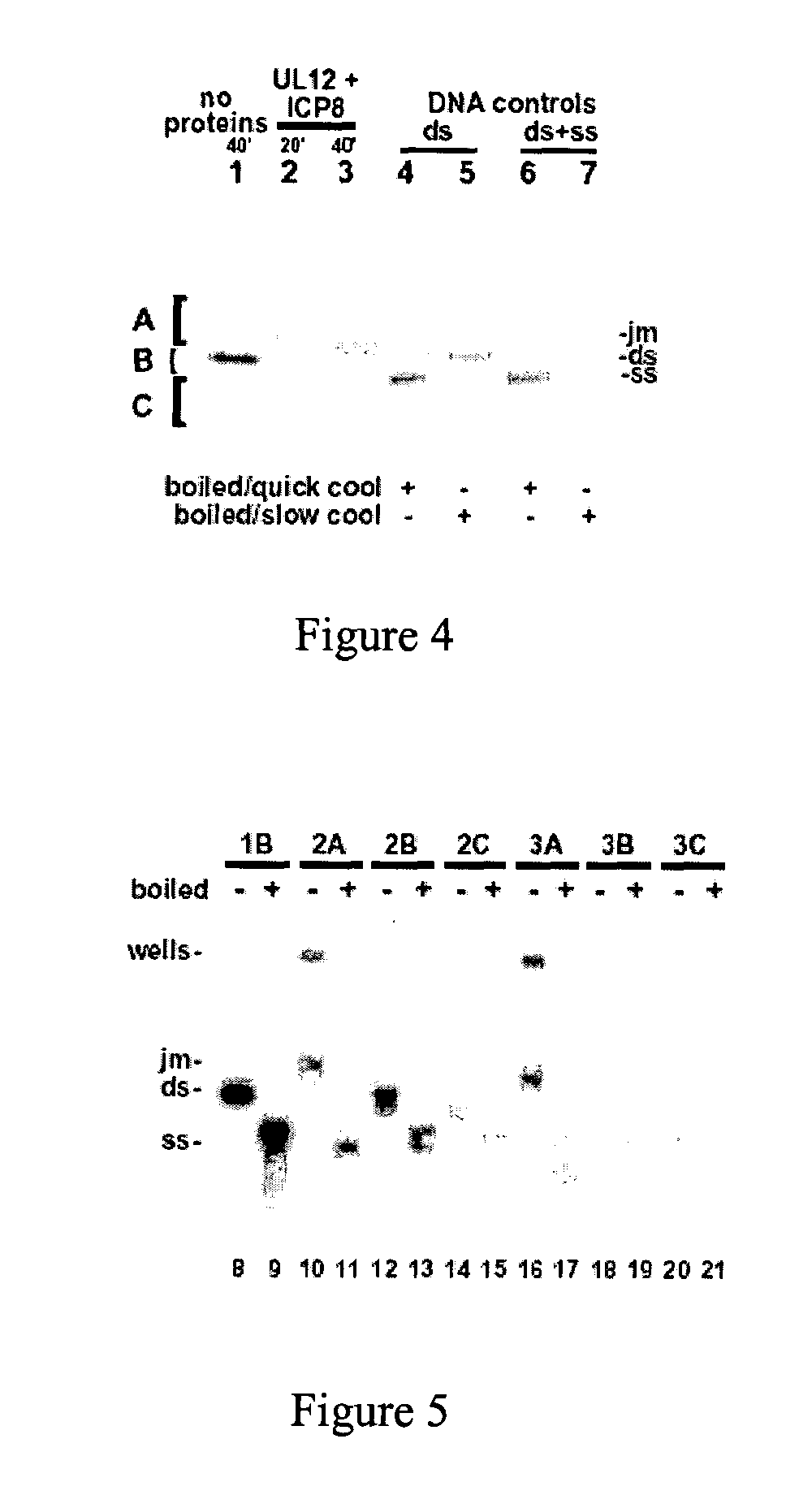Viral recombinases, related articles, and methods of use thereof
a technology of recombinases and viruses, applied in the field of viral recombinases, can solve the problems of complex and large genomes of higher organisms, and the manipulation of complex genomes is not a simple matter, and achieve the effect of facilitating heteroduplex formation
- Summary
- Abstract
- Description
- Claims
- Application Information
AI Technical Summary
Benefits of technology
Problems solved by technology
Method used
Image
Examples
example 1
[0120] Purification of UL12 and ICP8
[0121] The UL12 and UL12.sub.D340E proteins were purified as described (Goldstein, J. N. and Weller, S. W. (1998) Virology 244: 442-57). Briefly, UL12 was purified from Spodoptera frugiperda (Sf21) cells infected with recombinant baculovirus AcAN for wild-type and AcAN(IIAla) and AcAN(IIGlu) for the mutant strains.
[0122] The UL12.sub.D340E mutant protein is essentially devoid of exonuclease activity. Cells were collected 50 hours after infection, pelleted, quick-frozen, and stored at -75.degree. C. Cells were resuspended in 40 milliliters of buffer A (10 mM Tris-Cl pH 7.5, 1 mM MgCl.sub.2, 0.5 mM dithiothretol, 80 mM KCl,0.2% NP-40). Protease inhibitors (aprotinin, leupeptin, pepstatin A and phenylmethylsulfonyl fluoride) were added. Cells were incubated on ice for 10 minutes, then homogenized in a Dounce homogenizer. Nuclei were pelleted, and resuspended in 40 milliliters of Buffer A to extract nuclear proteins. The resuspension and pelleting was...
example 2
Strand exchange activity of UL12 and ICP8
[0124] An agarose gel-based strand exchange assay was used to test the ability of UL12 and ICP8 to promote strand exchange in vitro between linear double-stranded (ds) and circular single-stranded (ss) M13mp18 DNA. M13mp18 RF DNA was digested with BsrGI and gel purified. The purified DNA fragment was end-labeled by the exchange reaction, using T4 polynucleotide kinase, [.alpha.-.sup.32P] ATP, and the exchange reaction buffer supplied by the manufacturer. The labeled fragment was then re-ligated with T4 DNA ligase, and then cleaved by PstI. The labeled 7.25 kilobase fragment (full-length M13) was gel-purified.
[0125] The double stranded DNA substrate was internally labeled at a single site, on both strands of the molecule. This 7.25 kilobase fragment had [.sup.32P]-labeled nucleotides positioned 5.25 kilobases from the 5' end of the pairing strand, and 2 kilobases from the 5' end of the strand that would be displaced or degraded during strand e...
example 3
Validation of Identity of Displaced Strand
[0133] To further validate the identity of the displaced strand, the strand exchange reaction was analyzed by using a Southern blot (FIG. 6). Strand exchange assays were performed and loaded onto 1% agarose gels. Following electrophoresis, the DNA was blotted onto GeneScreen Plus membranes (Dupont) according to the manufacturer's suggested protocols. The oligonucleotide probes used to detect the M13 DNA strands were end-labeled with T4 polynucleotide kinase and [.gamma.-.sup.32P] ATP, using the "forward" reaction buffer supplied by the manufacturer (Life Technologies). The sequences of the two probes are as follows: SEQ ID NO:5 5'GTCGGTGACGGTGATAATTCACCTTTAATG, for detection of the pairing, or "minus" strand; and SEQ ID NO:6 5'CATTAAAGGTGAATTATCACCGTCACCGAC, for detection of the displaced, or "plus" strand.
[0134] Reactions were performed using unlabeled substrates, and duplicate samples originating from the same tubes (with the exception of ...
PUM
| Property | Measurement | Unit |
|---|---|---|
| pH | aaaaa | aaaaa |
| pH | aaaaa | aaaaa |
| pH | aaaaa | aaaaa |
Abstract
Description
Claims
Application Information
 Login to View More
Login to View More - R&D
- Intellectual Property
- Life Sciences
- Materials
- Tech Scout
- Unparalleled Data Quality
- Higher Quality Content
- 60% Fewer Hallucinations
Browse by: Latest US Patents, China's latest patents, Technical Efficacy Thesaurus, Application Domain, Technology Topic, Popular Technical Reports.
© 2025 PatSnap. All rights reserved.Legal|Privacy policy|Modern Slavery Act Transparency Statement|Sitemap|About US| Contact US: help@patsnap.com



